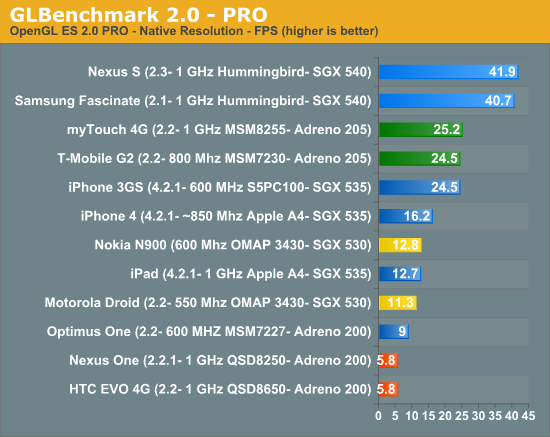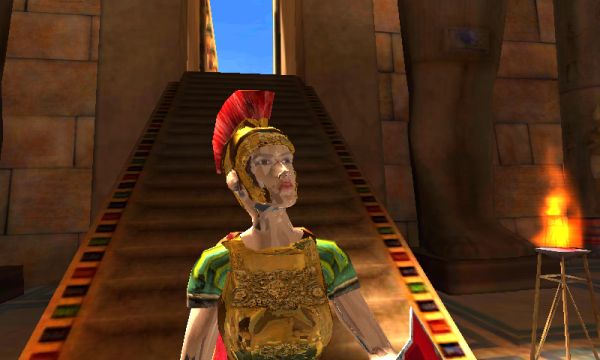GLBenchmark 2.0 Released - Modern SoCs Benchmarked
by Brian Klug on December 17, 2010 2:08 AM EST- Posted in
- Smartphones
- GLBenchmark
- Mobile
- SoCs
We're constantly on the lookout for new benchmarks to use for benchmarking the latest SoCs in devices. Today, Kishonti Informatics released GLBenchmark 2.0, the latest version of its popular GLBenchmark suite for measuring 3D graphics performance across a host of platforms: iOS, Android, Symbian, Windows Mobile, and Maemo. We've been testing it out for a while now and have some numbers of our own and from the community results. The end result is yet another look at how 3D performance stacks up between nearly all modern SoCs.
GLBenchmark 2.0 - as its name implies - tests OpenGL ES 2.0 performance on compatible devices. The suite includes two long benchmarking scenarios with a demanding combination of OpenGL ES 2.0 effects, and individual tests such as swap buffer speed (for determining the framerate cap), texture fill, triangle, and geometric tests. GLBenchmark 2.0 also leverages texture based and direct lighting, bump, environment, and radiance mapping, soft shadows, vertex shader based skinning, level of detail support, multi-pass deferred rendering, noise textures, and ETC1 texture compression.
We've been testing devices for a little while now and have a decent enough spread to make for some interesting comparison. The only extra consideration is that all of these were run at the device's respective native resolution. There's no way to change resolution, and likewise numbers cannot be scaled linearly because we may be memory bandwidth limited on some devices. GLBenchmark will join our benchmark suite for devices going forward.
First are the resolutions (native) of the devices themselves:
| Device Resolutions - GLBenchmark Native Resolution | |||||
| Google Nexus One | 800x480 WVGA | ||||
| LG Optimus One | 320x480 HVGA | ||||
| T-Mobile myTouch 4G | 800x480 WVGA | ||||
| Samsung Fascinate | 800x480 WVGA | ||||
| Google Nexus S | 800x480 WVGA | ||||
| HTC EVO 4G | 800x480 WVGA | ||||
| Apple iPhone 4 | 960x640 DVGA | ||||
| Apple iPad | 1024x768 XGA | ||||
| Motorola Droid | 854x480 FWVGA | ||||
| T-Mobile G2 | 800x480 WVGA | ||||
| Nokia N900 | 800x480 WVGA | ||||
| Apple iPhone 3GS | 320x480 HVGA | ||||
Thankfully, comparison across devices running Android is easy thanks to the relatively standard WVGA resolution guidelines for high end devices.


The first benchmark, Egypt, tests OpenGL ES 2.0 and represents the newest and most demanding benchmark. The second - GLBenchmark PRO - represents a suite that tests OpenGL ES 1.1 performance. (edit: GLBenchmark Pro also tests OpenGL ES 2.0 features, and is a port of an earlier GLBenchmark 1.1 test which focused on OpenGL ES 1.1 performance). Moving forward we will report these whenever possible on smartphone reviews.
It's pretty apparent right now that PowerVR SGX 540 still holds the lead, though the new 45 nm Qualcomms with Adreno 205 are a huge jump forwards from Adreno 200 performance wise. It's interesting that it looks like we're GPU or memory bandwidth bound on those new Qualcomms, as evidenced by the similar results the myTouch 4G and G2 post despite a 200 MHz CPU clock disparity.
Overall, GLBenchmark is designed to showcase some of the OpenGL ES 2.0 features that developers may potentially use in future gaming titles. There are a lot more low level tests which we'll be playing around with in the future and using to test in much more detail.

















64 Comments
View All Comments
metafor - Friday, December 17, 2010 - link
That really only makes sense if the benchmark is completely fill rate bound. Which it doesn't appear to be. There's more to 3D graphics than just filling the pixels on screen.marc1000 - Friday, December 17, 2010 - link
yep, they kept the same GPU but increased the resolution A LOT. this thing is looking bad for apple, because the new hummingbird is so much faster... if only the developers for android could leverage performance....ET - Friday, December 17, 2010 - link
The NookColor looks like it's going to be a good Android tablet to buy once it gets Android 2.2 and app store access next month. Can't help but wonder what kind of 3D performance it has.kilkennycat - Friday, December 17, 2010 - link
Would be very interesting to add the GLBenchmark 2.0 results for the upcoming Tegra2-based LG Optimus 2X phone to this collection. See:-http://www.dailytech.com/article.aspx?newsid=20411
Likely to blow away all the competition? Dual-core 1GHz A9 Cortex-ARM plus nV graphics.
Also, it now seems pretty obvious why Steve Jobs is running scared from the latest GPU-accelerated Adobe Flash 10.1/10.2. The iPhone and iPad are true graphics slugs...
marraco - Friday, December 17, 2010 - link
How pathetic is the iPad.xype - Friday, December 17, 2010 - link
Infinity Blade plays nicely on the iPad and the 3GS I have. As does Rage HD.But then, I haven't seen any comparison where those two were running on Android, so who knows, right?
silverblue - Friday, December 17, 2010 - link
The lack of cross-platform games isn't helping here.For one, I'd like to see how Asphalt 5 performs, but it seems frame-capped on or under-optimised for the Galaxy S. Give it a benchmark mode and you could compare the iPhones and Android devices in at least one title.
A benchmark for Angry Birds would likely be a waste of time as it's smooth enough.
headrush69 - Friday, December 17, 2010 - link
Obviously these tests are resolution dependent since the iPhone 3GS with a slower CPU and same SGX 535 beats the iPad and iPhone 4.As a result comparison direct comparison between Android and newer iOS devices isn't exact but it appears iOS devices are lagging.
One wonders if the SGX 540 used in new iOS devices will change that or if it's a poor Open GL ES stack implementation from Apple, same as on OS X.
marraco - Saturday, December 18, 2010 - link
1024x768 does not justify the difference.And the fruity company sells the screen size, so it should sell a fully functional unit.
It pretends to "sell a Ferrari", but without the Ferrari engine.
prdola0 - Friday, December 17, 2010 - link
Hello AT,the screenshots in the article show some serious rendering glitches. My guess is that part of the graphics memory is damaged. This is NOT how the benchmark should look. On which device did you get these results?
Best regards,
Prdola